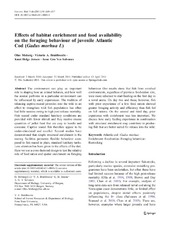| dc.contributor.author | Moberg, Olav | eng |
| dc.contributor.author | Braithwaite, Victoria A. | eng |
| dc.contributor.author | Jensen, Knut Helge | eng |
| dc.contributor.author | Salvanes, Anne Gro Vea | eng |
| dc.date.accessioned | 2011-11-23T12:22:06Z | |
| dc.date.available | 2011-11-23T12:22:06Z | |
| dc.date.issued | 2011-04-13 | eng |
| dc.identifier.issn | 0378-1909 | en_US |
| dc.identifier.uri | https://hdl.handle.net/1956/5221 | |
| dc.description.abstract | The environment can play an important role in shaping how an animal behaves, and how well the animal performs in a particular environment can be influenced by early experiences. The tradition of releasing captive-reared juveniles into the wild in an effort to strengthen wild fish populations has often had little success owing to high post-release mortality. Fish reared under standard hatchery conditions are provided with fewer stimuli and they receive excess quantities of pellet food that are easy to handle and consume. Captive reared fish therefore appear to be under-stimulated and overfed. Several studies have demonstrated that simple structural enrichment in the rearing facilities promotes flexible behaviour compared to fish reared in plain, standard hatchery tanks. Less attention has been given to the effects of the diet. Here we use a cross-factored design to test the relative role of food ration and spatial enrichment on foraging behaviour. Our results show that fish from enriched environments, regardless of previous food-ration size, were more reluctant to start feeding on the first day in a novel arena. On day two and three, however, fish with prior experience of a low food ration showed greater foraging activity and efficiency than fish fed on full rations. On the second and third day, prior experience with enrichment was less important. We discuss how early feeding experience in combination with structural enrichment may contribute in producing fish that are better suited for release into the wild. | en_US |
| dc.language.iso | eng | eng |
| dc.rights | Creative Commons Attribution Noncommercial | |
| dc.rights.uri | https://creativecommons.org/licenses/by-nc/2.0 | eng |
| dc.subject | Atlantic cod | eng |
| dc.subject | Foraging behaviour | eng |
| dc.title | Effects of habitat enrichment and food availability on the foraging behaviour of juvenile Atlantic Cod (Gadus morhua L) | en_US |
| dc.type | Peer reviewed | |
| dc.type | Journal article | |
| dc.description.version | publishedVersion | en_US |
| dc.rights.holder | Copyright the Author(s) 2011 | en_US |
| dc.identifier.doi | https://doi.org/10.1007/s10641-011-9803-5 | |
| dc.source.journal | Environmental Biology of Fishes | |
| dc.source.pagenumber | 449-457 | |
| dc.subject.nsi | VDP::Agriculture and fishery disciplines: 900::Fisheries science: 920 | en_US |
| dc.identifier.citation | Environmental Biology of Fishes 91(4): 449-457 | |
| dc.identifier.citation | 832832 | |
| dc.source.volume | 91 | |
| dc.source.issue | 4 | |

